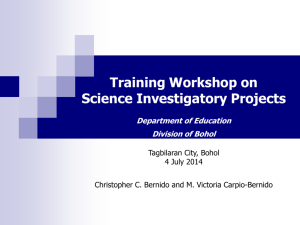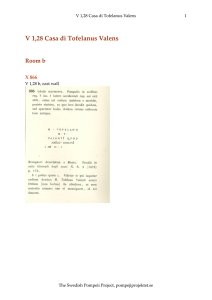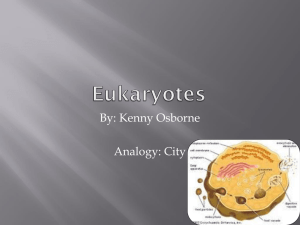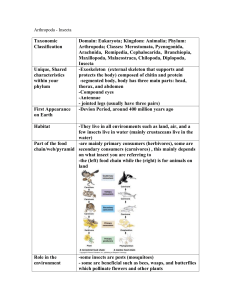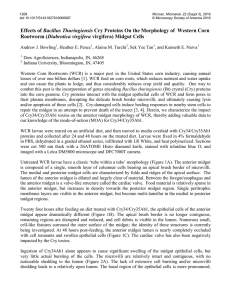Dendroctonus valens Diversity, Midgut Location, and Response to Alfa-pinene Enantiomers Introduction
advertisement
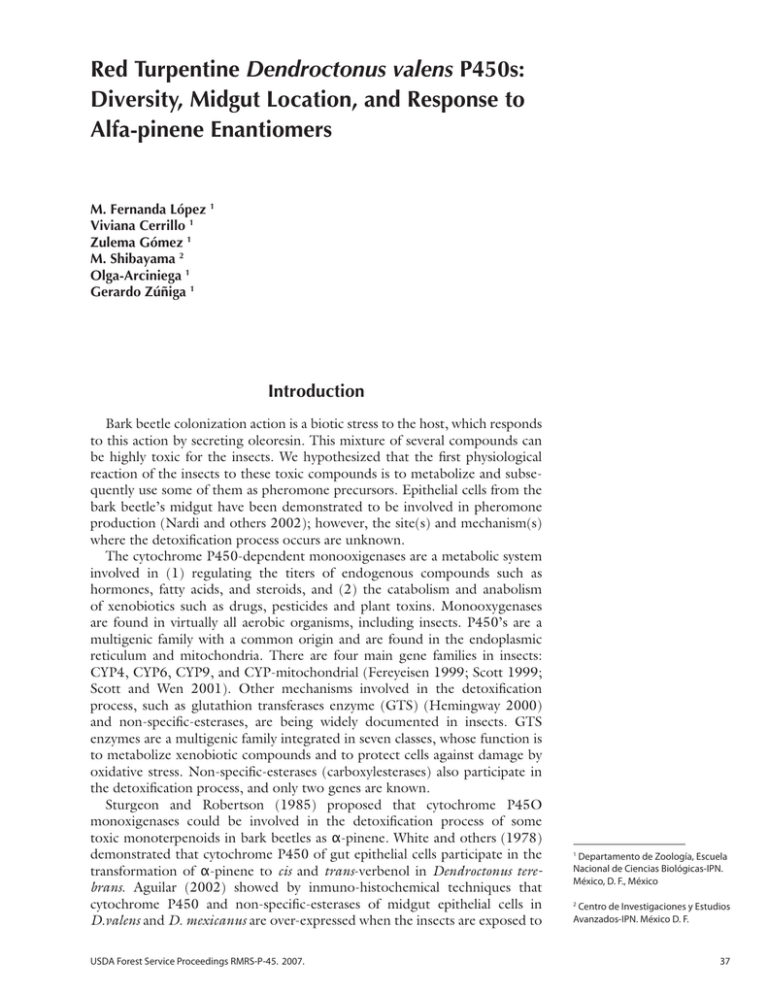
Red Turpentine Dendroctonus valens P450s: Diversity, Midgut Location, and Response to Alfa-pinene Enantiomers M. Fernanda López 1 Viviana Cerrillo 1 Zulema Gómez 1 M. Shibayama 2 Olga-Arciniega 1 Gerardo Zúñiga 1 Introduction Bark beetle colonization action is a biotic stress to the host, which responds to this action by secreting oleoresin. This mixture of several compounds can be highly toxic for the insects. We hypothesized that the first physiological reaction of the insects to these toxic compounds is to metabolize and subsequently use some of them as pheromone precursors. Epithelial cells from the bark beetle’s midgut have been demonstrated to be involved in pheromone production (Nardi and others 2002); however, the site(s) and mechanism(s) where the detoxification process occurs are unknown. The cytochrome P450-dependent monooxigenases are a metabolic system involved in (1) regulating the titers of endogenous compounds such as hormones, fatty acids, and steroids, and (2) the catabolism and anabolism of xenobiotics such as drugs, pesticides and plant toxins. Monooxygenases are found in virtually all aerobic organisms, including insects. P450’s are a multigenic family with a common origin and are found in the endoplasmic reticulum and mitochondria. There are four main gene families in insects: CYP4, CYP6, CYP9, and CYP-mitochondrial (Fereyeisen 1999; Scott 1999; Scott and Wen 2001). Other mechanisms involved in the detoxification process, such as glutathion transferases enzyme (GTS) (Hemingway 2000) and non-specific-esterases, are being widely documented in insects. GTS enzymes are a multigenic family integrated in seven classes, whose function is to metabolize xenobiotic compounds and to protect cells against damage by oxidative stress. Non-specific-esterases (carboxylesterases) also participate in the detoxification process, and only two genes are known. Sturgeon and Robertson (1985) proposed that cytochrome P45O monoxigenases could be involved in the detoxification process of some toxic monoterpenoids in bark beetles as α-pinene. White and others (1978) demonstrated that cytochrome P450 of gut epithelial cells participate in the transformation of α-pinene to cis and trans-verbenol in Dendroctonus terebrans. Aguilar (2002) showed by inmuno-histochemical techniques that cytochrome P450 and non-specific-esterases of midgut epithelial cells in D.valens and D. mexicanus are over-expressed when the insects are exposed to Departamento de Zoología, Escuela Nacional de Ciencias Biológicas-IPN. México, D. F., México 1 Centro de Investigaciones y Estudios Avanzados-IPN. México D. F. 2 USDA Forest Service Proceedings RMRS-P-45. 2007.37 α-pinene vapors. With respect to GTS enzymes, there are no reports in bark beetles. However, in Ips typographus, four esterase isozymes were detected that participate in detoxification processes and/or in the hydrolysis of juvenile hormone (JH) (Stauffer and others 1997). Previous histochemical studies of D. valens alimentary canal have shown that non-specific-esterases of midgut increase their activity when insects are exposed to α-pinene (Aguilar 2002). We are using D. valens as a model because it has been demonstrated that the monoterpenoids α -pinene, R-(+)-α-pinene, S-(-)-β-pinene, and S-(+)α-pinene are highly toxic compounds. They are also very important for their chemical communication system (Hobson and others 1992; White and Hobson 1993). In this species, we are studying the ultra-structural changes in the midgut epithelial cells of D. valens after exposure of the insects to αpinene. We are also studying the localization, diversity, and expression of CYP, non-specific-esterase and glutation–s-transferase genes in this region. Methods Ultrastructure Samples of D. valens were collected directly from infested trees and transported alive to our lab. The insects were exposed to α-pinene during 24 hours at 4 °C. The insects were then dissected to obtain the alimentary canal and to extract the midgut. The anterior and posterior midgut were sectionaed and they were fixed in Eppendorf tubes with glutaraldehide 2.5 percent and cacodilate buffer 1M. The samples were then processed with conventional transmission electron microscope techniques. P450 Complex The insects were exposed to α-pinene and its enantiomers: R-(+)-α-pinene, S-(-)-β-pinene, and S-(-)-α-pinene during 24 hours at 4 °C. Subsequently, total RNA of midgut was extracted with Trizol method and single-stranded cDNAs for RT-PCR were synthetized from total RNA with MMLV reverse transcriptase. The CYP4, CYP6, and CYP9 (P45O) genes were amplified with degenerated primers (Rose and others 1997; Snyder and others 1996). The expected bands were cut off from the gel and cDNA was isolated using the QIAEX II Gel Extraction Kit. The isolated products were reamplified and sequenced. The nucleotide sequences were compared with sequences deposited in GeneBank. Results and Discussion The Midgut Ultra-structure of Insects Without Alpha-pinene The midgut epithelium is composed of cylindrical cells with microvilli in the apical zone. The cells are limited by a basal membrane named basal lamina that forms invaginations in folds. The cytoplasm is granular and spongy. The nucleus is large-ovoid with one or several electron-dense nucleoli located in the center or mid part of the cell. The primary lysosomes are scarce and mitochondria are found in all the cytoplasm. Their crests have a normal structure and the rough endoplasmic reticulum is widely distributed. Ribosomes are found both free and adhered to the rough endoplasmic reticulum. It is very common to observe empty vacuoles and secretion vesicles irregularly scattered in all cytoplasm. 38 USDA Forest Service Proceedings RMRS-P-45. 2007. The Midgut Ultrastructure of Insects With Alpha-pinene The microvilli, nucleus, and vesicles maintain their original structure; however, it is common to observe a significant increase in the number of mitochondria on the basal and apical zone of the cells. The mitochondria crests are modified, the primary and secondary lysosomes are abundant, the rough endoplasmic reticulum is observed near to the nucleus arranged in parallel packages, and the Golgi complex is evident and maintains its structure with crests in block piles and it is found near of nucleus and the apical zone. The smooth endoplasmic reticulum is very conspicuous. It has a tubular shape with vesicles associated in its extreme with indefinite arrange. The differences observed in both experiments showed that α-pinene affects the midgut epithelial cells, changing and increasing the number of secondary lysosomes and mitochondria in the apical zone. The rough endoplasmic reticulum shows an overexpression. The Golgi complex and smooth endoplasmic reticulum are clearly evident. These ultrastructural changes suggest that these organelles participate actively in the detoxification process. P450 Gene Complex The midgut cDNA of stimulated insects amplify for a CYP4 gene (CYP4 family). The amplification product of this gene exhibited one band of the expected size of ~500bp. These products were sequenced, and Blast analysis showed that amino acid sequences of CYP4 of D. valens has a high identity (90, 91 percent) with CYP4G29 from Leptinotarsa decemliniata, and CYP4G15 from Tribolium castaneum. CYP6 and CYP9 genes have been amplified from total DNA of D. valens, and at this moment, we are amplifying these genes from midgut cDNA to obtain their sequences. These results show that three CYP genes are present in the midgut region. Future Work • The genes obtained (CYP4, CYP6, CYP9) will be cloned and sequenced to obtain subsequently complete genes using 5’ RACE method. We are testing the presence of CYP-mitochondrial (CYP12). • We are looking at where these CYP genes are located at ultrastructural level in D. valens midgut cells. • We are quantifying the expression levels of CYP genes using Real-Time PCR. • We are determining the midgut location and expression levels of other enzymes involved in the detoxification process, as esterases and Glutathion-S-Tranferases by histochemical and immunological methods, as well as by molecular techniques. References Aguilar, A. 2002. Localización de las enzimas involucradas en los procesos de digestión y destoxificación del tracto digestivo de tres diferentes especies del género Dendroctonus (Coleoptera: Scolytidae). Tesis de Maestria. ENCB-IPN. México D.F. Feyereisen, R. 1999. Insect P450 enzymes. Annual Reviews Entomological 44: 507-533. Hemingway, J. 2000. The molecular basis of two contrasting metabolic mechanisms of insecticide resistance. Insect Biochemistry and Molecular Biology 30: 1009-1015. USDA Forest Service Proceedings RMRS-P-45. 2007.39 Hobson, K. R.; Wood, D. L.; Cool, L. G.; White, P. R.; Ohtsuka, T.; Kubo, I.; Zavarin, E. 1992. Chiral specifity in responses by the bark beetle Dendroctonus valens to host kairomones. Journal of Chemical Ecology 19(9)1837-1846. Nardi, J. B.; Young, G. A.; Ujhelyi, E.; Tittiger, C.; Lehane, M. J.; Blomquist, G. J. 2002. Specialization of midgut cells for synthesis of male isoprenoid pheromone components in two scolytid beetles, Dendroctonus jeffreyi and Ips pini. Tissue & Cell 34: 221-231. Rose, L. R.; Goh, D.; Thompson, D. M.; Verma, K. D.; Heckel, D. G.; Gahan, L. J.; Roe, R. M.; Hodgson, E. 1997. Cytochrome P450 (CYP)9A1 in Heliothis virescens: The first member of a New CYP family. Insect Biochemistry and Molecular Biology 27(6) 605-615. Scott, J. G. 1999. Cytochromes P450 and insecticide resistance. Insect Biochemistry and Molecular Biology 29: 757-777. Scott, J. G.; Wen, Z. 2001. Cytochromes P450 of insects: The tip of the iceberg. Pest Management Science 57: 958-967. Snyder, M. J.; Scott, A. J.; Andersen, F. J.; Feyereisen, R. 1996. Sampling P450 diversity by cloning polymerase chain reaction products obtained with degenerate primers. Methods in Enzymology 22: 304-312. Stauffer, C.; Shiotsuki, T.; Chan, W.; Hammock, B. D.1997. Characterization of the Esterase Isozymes of Ips typographus (Coleoptera, Scolytidae). Archives of Insect Biochemistry and Physiology 34: 203-221. Sturgeon, K. B.; Robertson, J. L. 1985. Microsomal polysustrate monooxygenase activity in western and mountain pine beetles (Coleoptera: Scolytidae). Annals Entomological Society America 78: 1-4. White, R. A., Jr.; Franklin, R. T.; Agosin, M. 1978. Conversion of α-pineno oxide by rat liver and the bark beetle Dendroctonus terebrans microsomal fractions. Pest Biochemistry Physiology 10: 233-242. White, R. P.; Hobson, K. R. 1993. Stereospecific antennal response by red turpentine beetle, Dendronctonus valens to chiral monoterpenes from ponderosa pine resin. Journal of Chemical Ecology 19: 2193-2202. 40 USDA Forest Service Proceedings RMRS-P-45. 2007.

